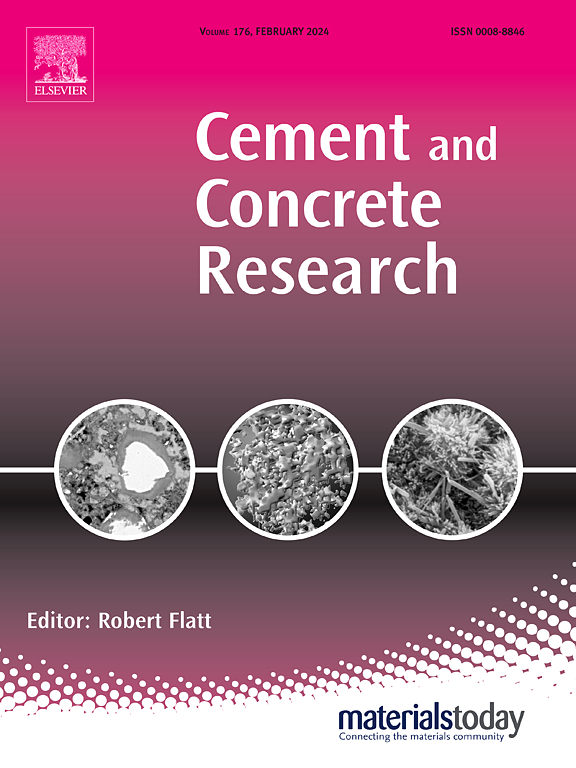Self-healing performance of thermally damaged ultra-high performance concrete: Rehydration and recovery mechanism
IF 10.9
1区 工程技术
Q1 CONSTRUCTION & BUILDING TECHNOLOGY
引用次数: 0
Abstract
Concrete suffers significant performance degradation when exposed to high temperatures. This study explored the beneficial role of waste glass powder (WGP) in mitigating thermal damage and ultra-high performance concrete (UHPC) after elevated temperature exposure. The mechanism was elucidated through the chemical and microstructure changes, the composition of hydrates after exposure to elevated temperatures, and the subsequent re-curing. The presence of WGP significantly enhanced the residual mechanical properties of UHPC due to more wollastonite generation. The WGP also facilitated the recovery of mechanical properties and surface morphology during the post-fire self-healing process. The microstructural results confirmed that the WGP promoted the formation of the wollastonite phase in the thermal-damaged UHPC by reacting with the dehydrated products. Thermodynamic simulations indicated that the incorporation of WGP in UHPC resulted in an increase of liquid phase and its early appearance at high temperatures led to the transformation of γ-C2S into more stable wollastonite phases. Meanwhile, the activation of unreacted WGP by limewater further generated secondary hydration products to reduce matrix porosity. These hydrates mainly consisted of C-(N)-S-H gels with a low calcium-to-silicon ratio (Ca/Si) and high sodium-to-silicon ratio (Na/Si) ratio, which could effectively fill the micropores and microcracks in UHPC. As a result, the densified microstructure induced by these regenerated C-(N)-S-H gels largely contributed to the recovery of the thermally damaged UHPC. The outcome of this study provides a decarbonization solution to address damages of UHPC exposed to fire conditions.
热损伤超高性能混凝土的自愈性能:再水化及恢复机理
当混凝土暴露在高温下时,其性能会显著下降。本研究探讨了废玻璃粉(WGP)在高温暴露后减轻热损伤和超高性能混凝土(UHPC)中的有益作用。通过化学和微观结构的变化、高温后水合物的组成以及随后的再固化来阐明其机理。WGP的存在显著提高了UHPC的残余力学性能,因为硅灰石生成更多。WGP还有助于在火灾后自愈过程中恢复机械性能和表面形态。显微结构结果证实,WGP通过与脱水产物反应,促进了热损伤UHPC中硅灰石相的形成。热力学模拟结果表明,WGP掺入UHPC导致液相增多,其在高温下的早期出现导致γ-C2S转变为更稳定的硅灰石相。同时,石灰水对未反应WGP的活化进一步产生二次水化产物,降低了基质孔隙度。这些水合物主要由低钙硅比(Ca/Si)和高钠硅比(Na/Si)的C-(N)- s - h凝胶组成,可以有效填充UHPC中的微孔和微裂缝。结果表明,这些再生的C-(N)- s - h凝胶诱导的致密微观结构在很大程度上促进了热损伤UHPC的恢复。本研究的结果为解决UHPC暴露于火灾条件下的损害提供了脱碳解决方案。
本文章由计算机程序翻译,如有差异,请以英文原文为准。
求助全文
约1分钟内获得全文
求助全文
来源期刊

Cement and Concrete Research
工程技术-材料科学:综合
CiteScore
20.90
自引率
12.30%
发文量
318
审稿时长
53 days
期刊介绍:
Cement and Concrete Research is dedicated to publishing top-notch research on the materials science and engineering of cement, cement composites, mortars, concrete, and related materials incorporating cement or other mineral binders. The journal prioritizes reporting significant findings in research on the properties and performance of cementitious materials. It also covers novel experimental techniques, the latest analytical and modeling methods, examination and diagnosis of actual cement and concrete structures, and the exploration of potential improvements in materials.
 求助内容:
求助内容: 应助结果提醒方式:
应助结果提醒方式:


